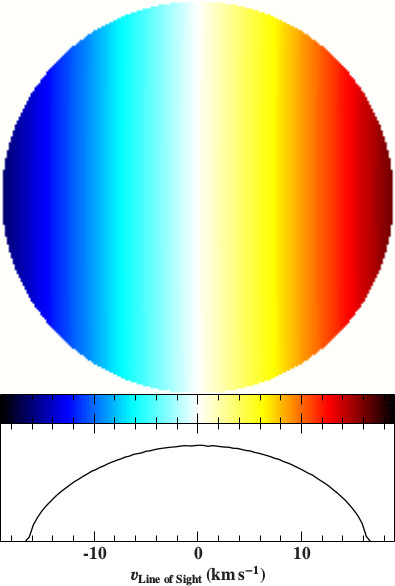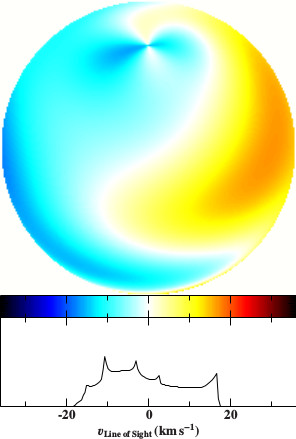
|

|

|
| Animations: Stellar pulsations |
| Articles about my work |
| Scientific publications |
 The spectral shape of stellar features depends on several broadening mechanisms. Among these, rotational broadening is one of the most important ones.
According to the Doppler effect, light, which is emitted from those regions on the projected stellar disk that approach the observer, is shifted to shorter wavelengths, i.e.,
bluewards, whereas light from receding regions is shifted to longer wavelengths, i.e., redwards. Scanning over the entire projected stellar disk and summing up the geometric
weights for each line-of-sight velocity yields the generic, time-independent rotational broadening profile
of a rotating star, which is a function of the projected equatorial velocity only.
The spectral shape of stellar features depends on several broadening mechanisms. Among these, rotational broadening is one of the most important ones.
According to the Doppler effect, light, which is emitted from those regions on the projected stellar disk that approach the observer, is shifted to shorter wavelengths, i.e.,
bluewards, whereas light from receding regions is shifted to longer wavelengths, i.e., redwards. Scanning over the entire projected stellar disk and summing up the geometric
weights for each line-of-sight velocity yields the generic, time-independent rotational broadening profile
of a rotating star, which is a function of the projected equatorial velocity only.
|
 The situation is much more complex for pulsating stars because the pulsational broadening profile is not only a function of time,
but also of roughly a dozen parameters that specify the pulsational mode. The profile shown here is a model for 18 Peg,
which is a slowly pulsating B-star with an oscillation period of about 1.4 days and a rotation period of about 24 days. The animation covers a time-span of 5 days.
The situation is much more complex for pulsating stars because the pulsational broadening profile is not only a function of time,
but also of roughly a dozen parameters that specify the pulsational mode. The profile shown here is a model for 18 Peg,
which is a slowly pulsating B-star with an oscillation period of about 1.4 days and a rotation period of about 24 days. The animation covers a time-span of 5 days.
|